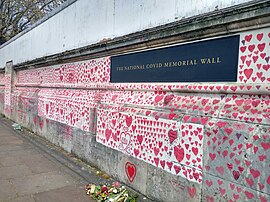National Covid Memorial Wall
| National Covid Memorial Wall | |
|---|---|
 Section of the National Covid Memorial Wall, April 2021 | |
| Artist | Covid-19 Bereaved Families for Justice |
| Year | 2021 |
| Subject | COVID-19 pandemic in the United Kingdom |
| Dimensions | 500 m (1/3 mi) |
| Location | London |
| Website | nationalcovidmemorialwall |
The National Covid Memorial Wall in London is a public mural painted by volunteers to commemorate victims of the COVID-19 pandemic in the United Kingdom.[1] Started in March 2021 and stretching more than one-third mile (five hundred metres) along the South Bank of the River Thames, opposite the Palace of Westminster,[2] the mural consists of approximately 240,000 red and pink hearts, one for each of the casualties of COVID-19 in the United Kingdom who died with COVID-19 on their death certificate.[3] The intent was for each heart to be "individually hand-painted; utterly unique, just like the loved ones we’ve lost".[4]
History[edit]
The mural was organized by campaign group Covid-19 Bereaved Families for Justice, with the help of the campaign group Led By Donkeys.[4][5] Volunteers cleaned the wall and removed graffiti before hand-painting approximately 150,000 red hearts over 10 days from 29 March 2021.[4][5] Bereaved families filled these hearts with messages and the names of lost loved ones, with more continuing to be added over subsequent months.[5] Though the project was started without council permission,[6] it gained widespread support and public recognition, so has not yet been removed by authorities.[7] As the hearts and text have faded, volunteers continue to repaint hearts with longer-lasting masonry paint, to rewrite dedications, and to add new dedications.[8]
Location[edit]
The mural stretches more than one-third mile (five hundred metres) along the South Bank of the River Thames from Westminster Bridge to Lambeth Bridge, opposite the Palace of Westminster. Being outside of St Thomas' Hospital, it also encompasses an older plaque dedicated to the 1994-6 human BSE outbreak.
Reactions[edit]
On 29 March 2021, Labour Party leader Keir Starmer visited the mural, which he described as a "remarkable memorial", before calling on Boris Johnson to visit the mural personally and engage with the families of the deceased.[3] Johnson later visited the wall for "quiet reflection" and was criticised by the co-founder of the group, who said that the visit, which did not include a meeting with bereaved families, was "a late evening visit under cover of darkness ... a cynical and insincere move that is deeply hurtful".[9][10] On 20 April 2021, the Archbishop of Canterbury, Justin Welby, visited the wall, saying "I was unprepared for the visual force of this wall. Because it’s high, It feels like a wave of grief breaking over us."
Future of the mural[edit]
As of April 2023, the mural was not considered finished, as volunteers continue to add hearts to match the UK's COVID-19 death toll.[11] In April 2021, plans were reported of using digital scanning technology to count the number of hearts on the wall.[12]
While the original plan for the unauthorised mural included provision to clean the area after a period of time,[3] campaigners have argued that the mural should remain indefinitely as a permanent memorial.[11][2] The former Prime Minister, Boris Johnson, had previously promised a "fitting and permanent" memorial to those who died from COVID-19 after the conclusion of the pandemic.[4] Discussions have begun between the Friends of the Wall (the bereaved volunteers who maintain the wall),[13] St. Thomas’ Hospital, and the local planning authority to explore how to work together to ensure this unique memorial can be preserved.
Gallery[edit]
-
The National Covid Memorial Wall seen from Westminster Bridge
-
Volunteers painting hearts at the National Covid Memorial Wall
-
One of the plaques of the National Covid Memorial Wall
-
First anniversary of the National Covid Memorial Wall
See also[edit]
References[edit]
- ^ "Walk the National Covid Memorial Wall". National Covid Memorial Wall. Retrieved 5 September 2021.
- ^ a b Emma Birchley (8 April 2021). "COVID-19: Huge London memorial wall marks scale of UK's coronavirus deaths – as families ensure loved ones don't 'disappear'". Sky News. Sky News. Retrieved 12 April 2021.
- ^ a b c Manpreet Kaur Sachdeva (30 March 2021). "COVID-19: Bereaved families paint mural of almost 150,000 red hearts to represent victims". Sky News. Sky News. Retrieved 14 January 2022.
- ^ a b c d "Covid bereaved begin work on memorial wall opposite Westminster". the Guardian. 29 March 2021. Retrieved 12 April 2021.
- ^ a b c Lynskey, Dorian (18 July 2021). "Wall of love: the incredible story behind the national Covid memorial". The Guardian. Retrieved 28 July 2021.
- ^ "Wall of hearts grows as a memorial to loved ones taken by coronavirus". the Guardian. 4 April 2021. Retrieved 1 September 2022.
- ^ "Future of Covid memorial wall still uncertain one year after the first heart". the Guardian. 29 March 2022. Retrieved 1 September 2022.
- ^ Muir, Ellie (11 January 2022). "London's Covid memorial wall has had a spruce-up". Time Out London. Retrieved 1 September 2022.
- ^ "Johnson visited Covid Memorial Wall 'under the cover of darkness'". Express and Star. 29 April 2021. Retrieved 1 May 2021.
- ^ Grylls, George (30 April 2021). "Boris Johnson visited pandemic memorial wall without meeting bereaved". The Times. Retrieved 1 May 2021.
- ^ a b "Covid memorial wall has 'got to stay', say bereaved families". ITV News. 8 April 2021. Retrieved 12 April 2021.
- ^ Whelan, Sean (31 March 2021). "London memorial wall remembers Covid-19 victims". RTE News. Retrieved 12 April 2021.
- ^ "heartbreaking pilgrimage of grieving covid families". Retrieved 1 April 2023.
External links[edit]
- Official website
- Crowdfunder for the maintenance of the UK Covid Memorial Wall




